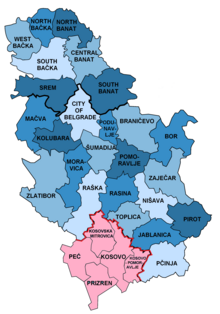Administrative divisions of Serbia
 |
|---|
|
|
The administrative divisions of Serbia (Template:Lang-sr / аdministrativna podela Srbije) are regulated by the Government of Serbia Enactment of 29 January 1992,[1] and by the Law on Territorial Organization adopted by the National Assembly of Serbia on 29 December 2007.[2][3]
Serbia is divided into 29 districts by the Enactment of 29 January 1992, while the units of the territorial organization are: municipalities and cities and autonomous provinces, by the Law on Territorial Organization.[2]
Regions

- Autonomous provinces
Serbia has two autonomous provinces: Vojvodina in the north (39 municipalities and 6 cities) and Kosovo and Metohija[2] in the south (28 municipalities and 1 city).
The province of Vojvodina has its own assembly and government. It enjoys autonomy on certain matters, such as infrastructure, science, education and culture.[4]
The Autonomous Province of Kosovo and Metohija has been transferred to the administration of UNMIK since June 1999, following the Kosovo War. In February 2008, the Government of Kosovo unilaterally declared independence from Serbia, a move recognized by 114 countries (including most of the European Union and the United States) but not recognized by Serbia, Russia, China, India, Spain, Brazil, Georgia, Indonesia or the United Nations.
- Statistical regions
The five statistical regions of Serbia are:
Districts

Districts are the first level administrative subdivisions of the country and largest entities, constituted of municipalities and cities. Districts are regional centers of state authority, but have no assemblies of their own; they present purely administrative divisions, and host various state institutions such as funds, office branches and courts. Districts are not defined by the Law on Territorial Organisation, but are organised under the Government's Enactment of 29 January 1992.[1]
Serbia is divided into 29 districts (7 in Vojvodina, 9 in Southern and Eastern Serbia, 8 in Šumadija and Western Serbia and 5 in Kosovo and Metohija), while the city of Belgrade presents a district of its own.
Municipalities and cities
- Municipalities
Serbia is divided into 145 municipalities and 29 cities,[2] which form the basic units of local government. Each municipality has its own assembly (elected every four years in local elections), a municipal president, public service property and a budget. Municipalities usually have more than 10,000 inhabitants.[2]
Municipalities comprise local communities, which mostly correspond to settlements (villages) in the rural areas (several small villages can comprise one local community, and large villages can contain several communities). Urban areas are also divided into local communities. Their roles include communication of elected municipal representatives with citizens, organization of citizen initiatives related with public service and communal issues. They are presided over by councils, elected in semi-formal elections, whose members are basically volunteers. The role of local communities is far more important in rural areas; due to proximity to municipal centers, many urban local communities are defunct.
- Cities
Cities are another type of local self-government. Territories with the status of "city" usually have more than 100,000 inhabitants,[2] but are otherwise very similar to municipalities. There are 27 cities, each having an assembly and budget of its own. Only cities have mayors, although the presidents of the municipalities are often referred to as "mayors" in everyday usage.
The city may or may not be divided into "city municipalities". Six cities, Belgrade, Novi Sad, Niš, Požarevac, Užice and Vranje comprise several municipalities, divided into urban and suburban areas. Competences of cities and their municipalities are divided. Of those, only Novi Sad did not undergo the full transformation, as the newly formed municipality of Petrovaradin exists only formally; thus, the City municipality of Novi Sad is largely equated to City of Novi Sad (and the single largest municipality in the country, with around 300,000 residents).
Subdivisions of Kosovo
Although the Serbian laws treat Kosovo as every other part of Serbia, and divide it into 5 districts, 28 municipalities and 1 city,[2] the UNMIK administration adopted new territorial organisation of Kosovo in 2000. This move is not recognized by Serbia, but is recognized by the self-proclaimed Republic of Kosovo. According to the new subdivision, Kosovo is divided into 7 (new) districts[citation needed] and 37 municipalities (8 new municipalities were created: Mališevo, Elez Han, Gračanica, Junik, Klokot-Vrbovac, Mamuša, Parteš and Ranilug).[5] The "Serb" districts function in the areas where Kosovo Serbs live, but are only recognized by Serbs, while the "UNMIK" districts, which function in all of Kosovo, are recognized only by Kosovo Albanians.
See also
- Historical administrative divisions of Serbia
- Statistical regions of Serbia
- Districts of Serbia
- Municipalities and cities of Serbia
- Cities and towns in Serbia
- Populated places in Serbia
References
- ^ a b Government of Serbia: Districts In Serbia
- ^ a b c d e f g Law on Territorial Organization and Local Self-Government Archived 2011-05-13 at the Wayback Machine, Parliament of Serbia Template:Sr icon
- ^ "Lokalni i pokrajinski izbori u maju". b92.net (in Serbian). Beta, Tanjug. 29 December 2007. Retrieved 20 March 2017.
- ^ Republic of Serbia. (in Serbian) – via Wikisource.
{{citation}}: Unknown parameter|trans_title=ignored (|trans-title=suggested) (help) Template:Sr icon - ^ Organization for Security and Co-operation in Europe Mission in Kosovo: Municipal profiles
Sources
- Balinovac, Zoran M.; Damjanović, Jasmina (2006). "The government and state administration system in the Republic of Serbia – compilation of laws and explanatory articles" (Document). Translated by Čavoški, Aleksandra; Vuruna, Dejan. Belgrade: Dial, Grafolik.
{{cite document}}: Unknown parameter|editor=ignored (help); Unknown parameter|isbn=ignored (help); Unknown parameter|url=ignored (help)




